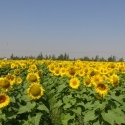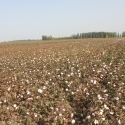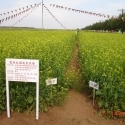09 Oct 2012
Demonstrating a link between nutrient use and water management to improve crop yields and nutrient use efficiency in arid Northwest China

Northwest China is characterized by dry growing conditions that limit crop yields and nutrient use efficiency. IPNI research trials evaluating the effect of different water and nutrient management scenarios on crop yield and nutrient use efficiency showed positive interactions between water supply and nutrients. The combined effect of sprinkler irrigation and improved nutrient management was better than flood irrigation with the same nutrient management. Drip irrigation was found to save water and N rate leading to improved N use efficiency compared with flood irrigation. Plastic-film mulching with bunch-seeding is another key approach to improve yield and nutrient use efficiency in arid regions.
Notes and Abbreviations: N = nitrogen, P = phosphorus, K = potassium
China’s Northwest belongs to an arid and semiarid region with an annual rainfall of 200 to 400 mm or less. Evaporation exceeds precipitation to a large degree in this region. Lack of moisture in the soil makes it a challenge to support adequate seedling growth in most spring seasons, and generally restricts agricultural production in the region.
To improve crop yields, farmers try to irrigate with limited water resources, and the use of water-saving irrigation including drip irrigation and low-pressure tube irrigation is growing rapidly (Table 1). Moreover, some effective methods of using limited rainfall have been developed over the last few years. For example, research in Gansu province has demonstrated that covering the land with plastic mulch or crop straw can reduce water losses by evaporation, as well as improve soil temperature (Wu et al., 2011). Research has also found that completely mulched double ridges and planting in furrows can support crop emergence with less than 10 mm rainfall (Liu et al., 2008). These rainfall collecting techniques allow the full use of limited rain water by reducing evaporation in favor of transpiration, and significantly increased crop yield compared with conventional non-mulched planting system.
Despite these advancements, a key challenge that remains is to manage nutrients under different water regimes to improve crop yields as well as both nutrient and water use efficiencies. In recent years, IPNI has focused on these issues in Northwest China. This article describes some of the research that demonstrates crop yield and nutrient/water use efficiency improvement by the appropriate use of nutrients and management of water.
Water and nutrient interaction in Cotton
Cotton is a major cash crop in Northwest China. An experiment evaluating the interaction between water and nutrients in Cotton in the Xinjiang province indicated a significant interaction between water and nutrient application. Low or medium water supply combined with medium nutrient supply produced higher lint yield as well as higher water and nutrient use efficiencies than other nutrient and water combinations (Table 2). The best nutrient response, leading to some of the highest lint yields was recorded with the lowest water application rate. The results showed that a balanced use of nutrients and irrigation water in combination can significantly increase crop yields more than nutrients and water alone.
Sprinkler versus flood irrigation
Experiments on nutrient application under flood and sprinkler irrigation systems in 2009 and 2010 in Wuchuan and Chayouzhong Qi counties of Inner Mongolia province clearly demonstrated the importance of nutrient and water combination in improving potato yields and nutrient use efficiency (Table 3). Potato tuber yields under sprinkler irrigation averaged 58.2 t/ha and 60.2 t/ha tuber in Chayouzhong and Wuchuan, respectively, which was significantly (P<0.05) more than that under flood irrigation in both locations. This effect cannot be attributed to irrigation system alone instead it was the result of a combined effect of nutrients and irrigation.
Although the amount of water used in both irrigation systems was the same, water use efficiency (WUE) was significantly (P<0.05) higher in the sprinkler system than in flood irrigation. Agronomic efficiency of N (AEN) was not affected by the irrigation system employed (Table 3). However, despite using higher N rate in the sprinkler system, N recovery efficiency (REN) was significantly (P<0.05) higher in the sprinkler system than in flood irrigation. In contrast, agronomic efficiency of P (AEP) with the sprinkler system was significantly (P<0.05) higher than in flood irrigation, while the P recovery efficiency (REP) was not affected. The effect of nutrient and water combination on agronomic efficiency of K (AEK) and K recovery efficiency (REK) was not consistent across the experimental sites.
Potato is more sensitive to water stress compared to many other crops and has a relatively shallow root-zone depth, which requires more frequent irrigation (Shock et al., 2007). In our study, 11 irrigations were applied during the potato growing season with the sprinkler system, using 15 mm with each application (a total of 165 mm of water). This low water application rate in the silt loam soils at two experimental locations improved uniform water distribution in soil (Stieber and Shock, 1995). On the contrary, only two time application of flood irrigation during the potato growing season normally resulted in low uniformity of water distribution in soils and deep percolation (Shock et al., 2007). This might explain why potato tuber yield and nutrient use efficiency under sprinkler irrigated system were better than under flood irrigation.
Drip versus flood irrigation
Although sprinkler irrigation improved crop yield and nutrient use efficiency (Table 3), this irrigation system does not fully save water in dry regions. A limited water resource requires water-saving irrigation techniques to reduce evaporation, and make most of the water available for crop transpiration to increase crop water use efficiency. Recently, in the irrigated areas more and more farmers have shifted to using drip irrigation. However, nutrient management, especially N application, has been both a challenge and an opportunity under these conditions.
IPNI conducted experiments on N management under flood and drip irrigation methods in irrigated potatoes grown on Chestnut soils in Wuchuan county of Inner Mongolia province. The results showed that when whole of the recommended N was applied as basal before planting under drip irrigation, it produced higher tuber yield and N recovery efficiency than 100% basal or split application under flood irrigation (Table 4). Using 50% of the recommended N applied as basal under drip irrigation produced potato tuber yield similar to the yield obtained with 100% recommended N under flood irrigation. The former also led to significantly higher N recovery efficiency when compared with the flood irrigation method. The results indicated that drip irrigation can save more water (630 m3/ha) and N fertilizer (105 kg/ha in 2009 and 120 kg/ha in 2010) than flood irrigation, while maintaining crop yields.
Under flood irrigation, split N application and 100% basal N application produced similar potato tuber yields, but higher N efficiency was obtained with split N application than with basal N application (Table 4).
Plastic-film mulching versus no mulching
Trials conducted in 2009 in the Dingxi county of Gansu province showed that potato mulched with plastic-film and bunch-seeding produced 83% more tuber yield than without plastic-film mulching under similar fertilizer use scenarios. Another experiment in wheat also indicated that the recommended NPK application (150-120-84 kg/ha) produced 42% more grain yield under plastic-film mulching with bunch-seeding than without plastic-film mulching. For both crops the plastic mulch improved AE of N and K as well as water use efficiency (Table 5).
The positive effect of plastic mulching can likely be explained by the effective maintenance of soil moisture content during earlier stages of plant growth, leaving a healthier moisture reserve deep in the soil (40-120 cm) for use during later crop growth stages (Li et al., 1999; Hou et al., 2010). In addition, plastic film mulching has been shown to improve soil surface temperature and increase crop growth at an early stage of plant development (Li et al., 2003). Our experiments clearly indicated that mulching, while expensive and labor-intensive, can improve nutrient use efficiency in arid regions where crops rely on the limited rainfall.
Conclusion
While China moves forward in its plan to sustain food security with population growth, an increasing emphasis will be placed on the arid northwest region of the country for additional food supplies. With the exception of water, growing conditions in the region are excellent for high yields of good quality food and cash crops. IPNI research in northwest China has clearly demonstrated that great potential exists to use both limited water supplies and fertilizer nutrients to optimize crop production and nutrient use efficiency, under both irrigated and rainfed conditions.
Dr. Shutian Li is Deputy Director, IPNI China program Northwest Region; e-mail:sli@ipni.net. Mr. Yu Duan is a Professor of Inner Mongolia Academy of Agricultural and Husbandry Sciences; e-mail: duanyu63@yahoo.com.cn. Mr. Tianwen Guo, Professor of Gansu Academy of Agricultural Sciences: e-mail: guotw11@sohu.com. Mrs. Yan Zhang is Professor of Xinjiang Academy of Agricultural Sciences; e-mail: yanzhangyz@sohu.com.
References
Wu, J.C., X.J. Guan, and Y.H. Yang. 2011. Chinese J. Applied Ecol. 22(1): 86-92. (in Chinese)
Liu, G.C., Q.F. Yang, R.Q. Duan, and X.W. Zhao. 2008. Research of Agricl. Modernization 29 (5): 629-632. (in Chinese)
Li F.M., A.H. Guo, and H. Wei. 1999. Field Crops Res. 63 (1): 79 - 86.
Hou H.Z., J.F. Lv, X.C. Zhang, R.P. Yang, and T.W. Guo. 2010. Crops, 1: 21-25. (in Chinese)
Li S.Q., D.F. Li, F.M. Li, H.Y. Bai, L. Ling, and J. Wang. 2003. J. Northwest Sci. Tech. Univ. Agril. and Forestry (Nature Sci. Ed.) 31 (5): 21-29.
Stieber T.D. and C.C. Shock. 1995. Am. Potato J. 72: 533-543.
Shock C.C., A.B. Pereira, and E.P. Eldredge. 2007. Am . J. of Potato Res. 84: 29-37.
Table 1. Area and ratio of irrigated area in China Northwest region.
| Province | Planting area, M ha | Irrigated area, M ha | Irrigated area, % total area | Water-saving irrigationa, M ha | Water saving irrigation as a % of total irrigated area |
| IMARb | 6.86 | 2.87 | 41.8 | 2.01 | 70.0 |
| Shaanxi | 4.17 | 1.30 | 31.2 | 0.84 | 64.6 |
| Gansu | 3.87 | 1.26 | 32.6 | 0.80 | 63.5 |
| Qinghai | 0.51 | 0.25 | 49.0 | 0.07 | 28.0 |
| Ningxia | 1.21 | 0.45 | 37.2 | 0.23 | 51.1 |
| Xinjiang | 4.49 | 3.57 | 79.5 | 2.55 | 71.4 |
bIMAR refers to Inner Mongolia province
Table 2. Effect of water and nutrient on cotton lint yield (kg/ha) in Xinjiang province, 2003.
| Nutrient Water | 113-69-27 N-P2O5-K2O, kg/ha | 226-138-54 N-P2O5-K2O, kg/ha | 340-207-81 N-P2O5-K2O, kg/ha |
| 2400 m3/ha | 1,239 | 1,496 | 1,575 |
| 3000 m3/ha | 1,315 | 1,608 | 1,330 |
| 3600 m3/ha | 1,250 | 1,437 | 1,253 |
| Significant at Pr>F | Water | Nutrient | Water ×Nutrient |
| * | *** | * |
Table 3. Water/nutrient management on potato tuber yield and N use efficiency in Inner Mongolia province (2009-2010).
| Year/Location | Irrigation methoda | Average yield, t/ha | AEN kg/kg N | AEp kg/kg P2O5 | AEk kg/kg K2O | REN % | REP % | REK % | WUE kg/ha/mm |
| 2009/ Chayouzhong | Flood | 35.9 b | 42.3 a | 65.2 b | 62.2 a | 31.4 b | 16.6 a | 43.1 b | 239.3 b |
| Sprinkler | 58.2 a | 43.3 a | 100.0 a | 63.7 a | 40.3 a | 16.9 a | 55.0 a | 352.7 a | |
| 2010/ Wuchuan | Flood | 37.5 b | 38.6 a | 59.4 b | 44.3 b | 33.5 b | 19.8 a | 59.2 a | 250.0 b |
| Sprinkler | 60.2 a | 41.1 a | 133.3 a | 86.4 a | 38.2 a | 20.6 a | 55.9 a | 364.8 a |
*Numbers followed by the same letter within the same column and for each year/location were not significantly different at P<0.05.
Table 4. Combination effect of drip irrigation and N management on potato tuber yield and N use efficiency in Inner Mongolia province (2009-2010)
| Year | N Managementa | Irrigation | Average tuber yield, t/ha | Mean REN, % | Mean WUE, kg/ha/mm |
| 2009 | 100% N basal | Drip | 37.0 a | 34.6 b | 428.2 a |
| 50% N basal | Drip | 33.3 b | 50.8 a | 385.4 b | |
| 30% N basal + 70% N topdressing at flowering | Flood | 33.3 b | 23.7 c | 222.0 c | |
| 100% N Basal | Flood | 31.6 b | 17.2 d | 210.7 c | |
| 2010 | 100% N basal | Drip | 37.5 a | 33.5 b | 434.0 a |
| 50% N basal | Drip | 32.9 b | 42.1 a | 380.8 b | |
| 30% N basal + 70% N topdressing at flowering | Flood | 35.0 b | 29.7 bc | 233.3 c | |
| 100% N Basal | Flood | 34.4 b | 26.4 c | 229.3 c |
*Numbers followed by the same letter within the same column and for each year are not significantly different at P<0.05.
Table 5. Effect of plastic-film mulching on potato tuber yield and nutrient use efficiency in Dingxi county of Gansu province (2009)
| Crops | Water regime | N-P2O5-K2O applied, kg/ha | Tuber yield, kg/ha | AEN kg/kg N | AEp kg/kg P2O5 | AEk kg/kg K2O | WUE, kg/ha/mm |
| Rainfed potato | Plastic-film mulching | 225-105-90 | 16,616 a | 10.6 a | 14.1 a | 31.9 a | 61.1 a |
| No mulching | 225-105-90 | 9,066 b | 8.6 a | 14.1 a | 12.5 b | 33.3 b | |
| Rainfed wheat | Plastic-film mulching | 150-120-84 | 2,411a | 5.1 a | 4.9 a | 1.9 a | 8.9 a |
| No mulching | 150-120-84 | 1,693b | 0.8 b | 0.4 b | -0.8 a | 6.2 b |
**Numbers followed by the same letter within the same column and for each crop were not significantly different at P<0.05.
Sprinkler irrigation improved potato tuber yield and nutrient use efficiency
Drip irrigation not only helped save water but also improved potato tuber yield and N use efficiency
Plastic-film mulched potato (left) and wheat (right) made full use of rain water and improved crop yield and nutrient use efficiency




